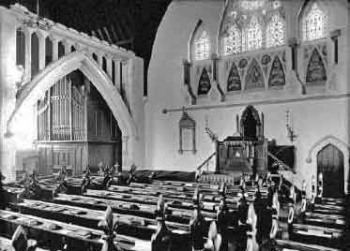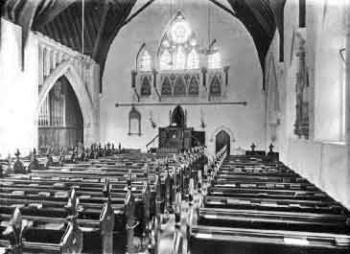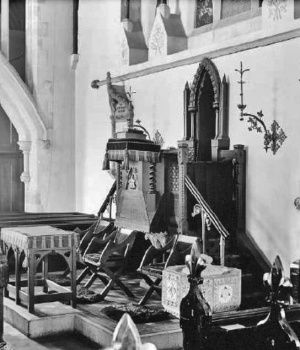Initially services were held in a hotel, and the church was opened in 1859 as part of the Free Church of Scotland. However, the distance between the church and its Scottish headquarters led to a switch to the Presbyterian Church of England, until 1972 when the church reverted to the governance of the Church of Scotland.
History
From the official church website, extracted from The Story of the Presbyterian Church In Jersey by the Rev James Adamson, Jersey 1937 and George Sinclair, Jersey 2004
In 1850 there was a garrison at Fort Regent comprising members of the Cameron Regiment with many Presbyterians in their ranks. They expressed a grievance that there was no church for them to worship in Jersey. This reached the ears of a retired soldier in the island, a Captain Ramsey, who shared their plight.
Rev James Stewart
He asked a Rev Guthrie in Edinburgh for help and this led to a young probation-minister arriving in the island. Rev James Stewart began holding services in the Town Hall (then in Don Street) in November 1850 which attracted large numbers of soldiers and local islanders.
The Cameron Regiment left Jersey in the Spring of 1851 but the islanders refused to part with their young minister and applied to the General Assembly of the Free Church of Scotland for recognition as a congregation of the Church.
The Sacraments of Baptism and the Lord’s Supper were celebrated for the first time on 20 July 1851.
The induction of the young Rev James Stewart as the congregation’s first minister was held on the 17 October 1852. However, the young Rev Stewart’s health deteriorated rapidly and he returned home to Scotland and died on 31 July 1853. A marble tablet in memory of the man considered the Founder of the Jersey congregation is to be found on the east wall inside the church.
In March 1853 the congregation was placed under the care of the Presbytery of Edinburgh.
Rev A J Murray
The Rev A J Murray was ordained as minister in June 1856 he instigated a search for a plot of land on which to build a church. By the end of 1856 a suitable plot at the corner of Midvale and Clairvale Roads (“in a pleasant part of town”) was bought for £287 – and sworn at the Royal Court on 15 December 1856.
The foundation stone was laid by Lord Parmoor at the end of 1857 and the church was opened for worship on 3 April 1959. The services that day were conducted by the Rev Dr Mc Crie (former Moderator of the Free Church Assembly) in the morning and evening and by the Rev Murray in the afternoon. Total cost of the church, including the land, was £2,618 and this sum was finally paid off in full on the sixth anniversary of the building in 1866.
The Rev Murray presented the church with the beautiful baptismal font made of Caen stone and adorned with pieces of coloured marble brought by him from Jerusalem in 1860.
Transfer
For travel and accessibility reasons the Free Church Presbytery of Edinburgh agreed to a transfer of responsibility for Jersey to England. In 1868 Jersey became the first Scottish congregation to unite with the Presbyterian Church in England. In 1869 the Clameur de Haro was raised by some members who had second thoughts about moving to the Presbyterian Church of England
Church hall
To cater for some 130 regular Sunday School scholars a plot of land next to the church was purchased in order to build a church hall. The new Hall was opened in January 1874, comprising a caretaker’s ground floor flat and a large room upstairs.
An organ fund was successful and a pipe organ was installed in August 1884. It was first located in the middle of the gallery at the back of the church but was later moved to the present transept area. This was still not satisfactory and a new eastern transept was built where the organ remains to this day.
The church received an unusual gift in 1903. A member of the congregation donated two large brass panels engraved with the ten commandments. These were fixed to the wall on either side of the pulpit where they remain to this day.
A warm summer’s day on 30 July 1926 saw a 5.5 (Richter scale) earthquake strike Jersey at 2.20 pm. Significant damage was caused, including to the church steeple, the top section of which shifted out of line. The epicentre was said to be off Jersey’s east coast at a depth of 10 km. Seven months later (17 February 1927) a second earthquake of equal force struck the island with the same epicentre but less damage.
Change of name and affiliation
In 1959 the congregation agreed that the church be renamed St Columba’s instead of the Presbyterian Church.
Following a long period of debate and discussion the congregation faced a major decision in 1971. There was a proposal from the presbytery of England that the church should join with the Congregational Church to become the new United Reformed Church. The minister at the time, the Rev W T Y Browne, was strongly against this proposal and counteracted this (joined by the Scottish church of St Andrews in Guernsey) by proposing that St Columba’s seek to rejoin the Church of Scotland. Eventually, the congregation voted 121 – 17 not to join the new United Reformed Church but to seek admission to the Church of Scotland. In May 1972 the General Assembly of the Church of Scotland approved St Columba’s application. So, 104 years after leaving the Free Church of Scotland in 1868 because of travelling difficulties between Jersey and Edinburgh, St. Columba’s was now back with the Church of Scotland.
Steeple demolished
The church steeple had been causing concern for many years – starting after the earthquake damage in 1926. Deterioration over the years made its demolition inevitable and in 1986 it was brought down at a cost to the congregation of £15,000.
The large rose window above the pulpit was the next piece of church fabric to require attention when it started to show structural failure. In 1988 it was repaired and reinstated at huge cost to the congregation – another £15,000.






